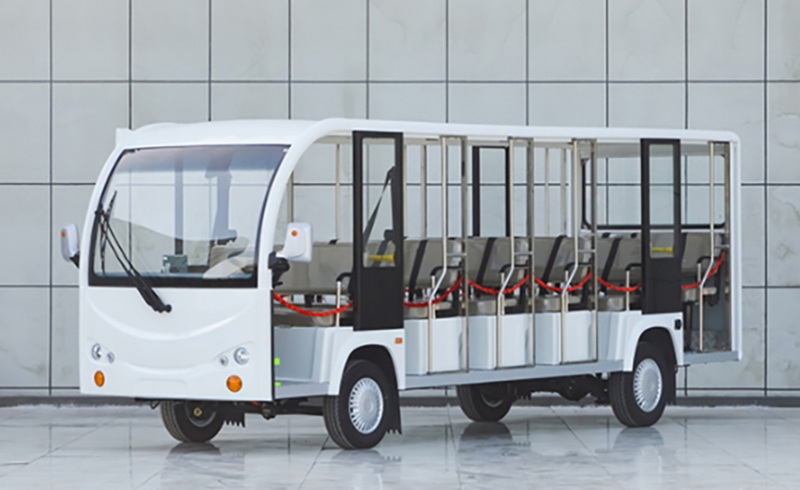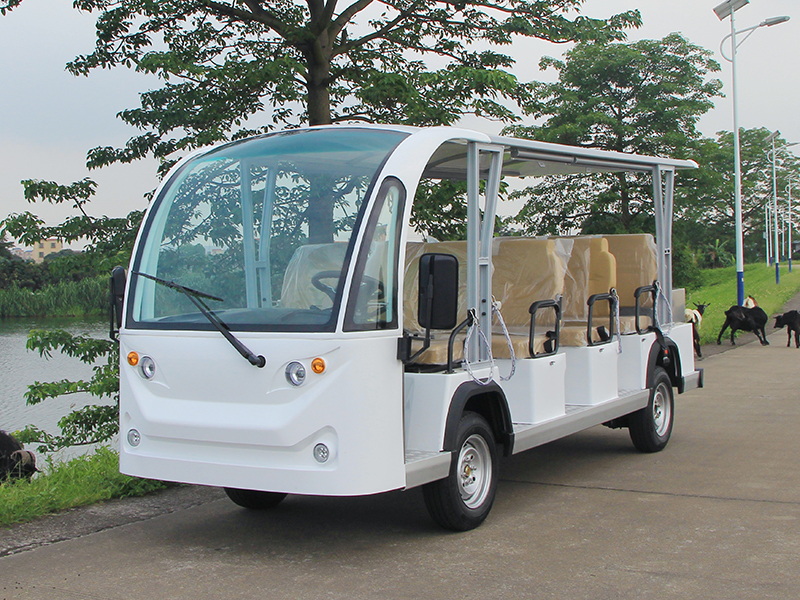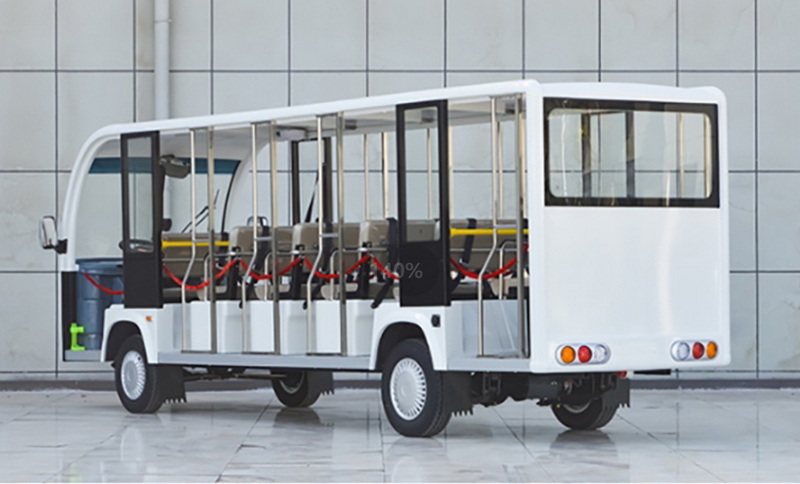Content Menu
● What Is An Electric Sightseeing Car?
>> Key Features
● How Does An Electric Sightseeing Car Work?
>> 1. Electric Motor
>> 2. Battery System
>> 3. Controller
>> 4. Charging System
>> 5. Steering and Braking
>> 6. Additional Features
● Advantages of Electric Sightseeing Cars
>> Eco-Friendly Operation
>> Cost-Effective
>> Quiet Operation
>> Safety and Comfort
>> Versatility and Customization
>> Low Maintenance
● Applications of Electric Sightseeing Cars
>> Tourism and Sightseeing
>> Resorts and Hotels
>> Theme Parks and Amusement Centers
>> Urban Pedestrian Areas and Airports
>> Campus and Community Transport
>> Special Events and Exhibitions
● Future Trends in Electric Sightseeing Car Design and Technology
>> Lithium Battery Technology
>> Smart Features
>> Enhanced Comfort
>> Solar Panels
>> Modular Designs
>> Connectivity and Data Analytics
● Conclusion
● FAQ
>> 1. What is the typical passenger capacity of an electric sightseeing car?
>> 2. How long does it take to charge an electric sightseeing car?
>> 3. What is the maximum speed of an electric sightseeing car?
>> 4. Are electric sightseeing cars suitable for all terrains?
>> 5. Can electric sightseeing cars be customized?
Electric sightseeing cars have become a popular and eco-friendly mode of transportation in tourist destinations, resorts, theme parks, and urban pedestrian areas worldwide. These vehicles combine modern electric technology with practical design to offer a quiet, efficient, and sustainable way for visitors to explore scenic spots and large venues. This article explores what an electric sightseeing car is, how it operates, its advantages, applications, and future trends. We also include a detailed FAQ section to provide a comprehensive understanding.

What Is An Electric Sightseeing Car?
An electric sightseeing car is a low-speed electric vehicle designed specifically for transporting passengers around tourist attractions, resorts, parks, campuses, and other large venues. Unlike traditional gas-powered vehicles, these cars run entirely on electric power, making them environmentally friendly and quiet. They often resemble golf carts or small shuttle buses and can vary in size from 4 to over 20 seats depending on the model and application.
Key Features
- Electric Motor: Powered by rechargeable batteries, usually lithium or maintenance-free lead-acid types.
- Passenger Capacity: Typically ranges from 4 to 28 passengers.
- Speed: Maximum speeds generally range from 20 to 30 km/h, optimized for safety and comfort.
- Design: Customizable with features like canopies, windshields, LED lighting, multimedia systems, and safety belts.
- Terrain Capability: Suitable for smooth pavements, parks, and even some uneven terrains.
- Environmental Impact: Zero tailpipe emissions, contributing to cleaner air and reduced noise pollution.
Electric sightseeing cars are often designed with open sides or large windows to maximize sightseeing opportunities, allowing passengers unobstructed views of their surroundings. Some models come equipped with weather protection such as retractable canopies or full glass enclosures to ensure passenger comfort in various climates.
How Does An Electric Sightseeing Car Work?
Electric sightseeing cars operate through a simple yet efficient electric drivetrain system. Here's a breakdown of the main components and their functions:
1. Electric Motor
The core of the vehicle is an electric motor, commonly rated between 5 kW to 7.5 kW for passenger models. This motor converts electrical energy from the batteries into mechanical power to drive the wheels. Electric motors provide instant torque, allowing smooth acceleration and responsive handling, which is especially beneficial for navigating crowded or narrow pathways in tourist areas.
2. Battery System
Most electric sightseeing cars use a battery pack (often 72V systems with 6 to 12 cells) that stores electrical energy. These batteries are rechargeable and maintenance-free, providing a range of approximately 80 to 100 km per full charge. Lithium-ion batteries are becoming increasingly popular due to their lighter weight, higher energy density, and longer lifespan compared to traditional lead-acid batteries.
3. Controller
The electronic controller manages power delivery from the battery to the motor, ensuring smooth acceleration and efficient energy use. Advanced controllers also optimize climbing ability and speed control, adapting power output to terrain and passenger load. Some models feature regenerative braking systems that recover energy during deceleration, further extending battery life.
4. Charging System
Built-in chargers allow the batteries to be recharged from standard electrical outlets, typically requiring 8 to 10 hours for a full charge. Fast-charging options are also emerging, reducing downtime and increasing operational efficiency, especially in commercial settings.
5. Steering and Braking
Electric sightseeing cars feature power-assisted steering (rack and pinion systems) for easy maneuverability and advanced braking systems including front disc brakes and rear drum brakes for safety. Some models incorporate electronic parking brakes and anti-lock braking systems (ABS) to enhance passenger security.
6. Additional Features
Many models come equipped with multimedia systems for entertainment, safety belts, LED lights for visibility, and weather protection such as canopies or full glass doors. Some vehicles also include accessibility features like wheelchair ramps or lifts, making them inclusive for all passengers.

Advantages of Electric Sightseeing Cars
Eco-Friendly Operation
Electric sightseeing cars produce zero emissions during operation, making them ideal for environmentally sensitive areas such as nature reserves, historical sites, and resorts. Their use helps reduce the carbon footprint of tourism activities and contributes to cleaner air quality in crowded tourist destinations.
Cost-Effective
Electric vehicles have lower operational costs compared to gas-powered cars. Electricity is cheaper than fuel, and electric motors require less maintenance due to fewer moving parts. Over time, the savings on fuel and maintenance can be substantial, especially for businesses operating fleets of sightseeing cars.
Quiet Operation
Their whisper-quiet engines minimize noise pollution, enhancing the sightseeing experience by allowing passengers to enjoy the natural sounds and ambiance of the surroundings. This quiet operation also benefits wildlife in natural parks and urban areas where noise restrictions are in place.
Safety and Comfort
Equipped with safety features like responsive brakes, seat belts, and ergonomic seating, these cars prioritize passenger security and comfort. The low speed and stable design reduce the risk of accidents, while features such as suspension systems and padded seats improve ride quality.
Versatility and Customization
They can be customized in size, color, and features to fit specific needs, from small 4-seaters to luxury 28-passenger shuttle buses with multimedia systems and full glass doors. Custom paint jobs, branding, and interior layouts allow operators to tailor vehicles to their unique requirements and enhance the visitor experience.
Low Maintenance
Electric sightseeing cars have fewer mechanical components than combustion engine vehicles, leading to reduced wear and tear. This translates into lower maintenance costs and less downtime, which is critical for commercial operators.
Applications of Electric Sightseeing Cars
Electric sightseeing cars serve a wide range of uses in various environments:
Tourism and Sightseeing
Ideal for guided tours in cities, parks, and cultural sites, these vehicles help tourists cover large areas comfortably without physical strain. They enable visitors to explore scenic routes, historical landmarks, and large outdoor venues with ease.
Resorts and Hotels
They provide convenient guest transportation within large properties, including luggage transport and facility tours. Many resorts use electric sightseeing cars to shuttle guests between accommodations, restaurants, and recreational areas.
Theme Parks and Amusement Centers
Used for guest shuttling, VIP tours, and mobility assistance, these cars enhance visitor experience in large entertainment venues. Their quiet operation allows them to blend seamlessly into the park environment without disturbing attractions.
Urban Pedestrian Areas and Airports
Their compact size and low speed make them perfect for pedestrian zones, airports, ports, and docks where quiet, clean transport is essential. They are often used to transport passengers with limited mobility or to connect terminals and parking areas.
Campus and Community Transport
Electric sightseeing cars are also used in university campuses, gated communities, and industrial parks for efficient short-distance travel. They provide a cost-effective and sustainable alternative to personal vehicles for daily commuting within these areas.
Special Events and Exhibitions
Temporary deployment of electric sightseeing cars at large events, fairs, and exhibitions helps manage crowd movement and provides comfortable transport for attendees, especially in sprawling venues.
Future Trends in Electric Sightseeing Car Design and Technology
The future of electric sightseeing cars is shaped by innovations in sustainability, intelligence, and passenger-centric design:
Lithium Battery Technology
More efficient, lighter, and longer-lasting batteries will extend range and reduce charging time. Solid-state batteries and other emerging technologies promise even greater energy density and safety.
Smart Features
Integration of GPS, autonomous driving capabilities, and passenger information systems will enhance operational efficiency and user experience. Autonomous electric sightseeing cars could provide on-demand, driverless tours in the near future.
Enhanced Comfort
Improved suspension systems, climate control, and luxury interiors will make rides smoother and more enjoyable. Features like adjustable seats, panoramic roofs, and noise-cancelling cabins are being explored.
Solar Panels
Some models are incorporating solar panels to supplement battery charging for extended operation. This renewable energy source can reduce reliance on grid electricity and increase sustainability.
Modular Designs
Flexible configurations to switch between passenger and cargo modes will increase versatility. Operators will be able to adapt vehicles quickly for different tasks, such as transporting goods or providing shuttle services.
Connectivity and Data Analytics
Real-time monitoring of vehicle performance, battery health, and passenger usage patterns will allow operators to optimize fleet management and maintenance schedules, reducing costs and improving reliability.
Conclusion
Electric sightseeing cars represent a modern, sustainable, and efficient solution for short-distance passenger transport in tourism, hospitality, and urban environments. Their eco-friendly operation, cost-effectiveness, quietness, and safety features make them an excellent choice for businesses and communities looking to reduce their environmental impact while enhancing visitor experience. With ongoing technological advancements, electric sightseeing cars will continue to evolve, offering smarter, more comfortable, and versatile transportation options for the future.

FAQ
1. What is the typical passenger capacity of an electric sightseeing car?
Electric sightseeing cars typically range from 4 to 28 passengers, with popular models seating 11 or 14 people.
2. How long does it take to charge an electric sightseeing car?
Most models require 8 to 10 hours to fully charge using a standard electrical outlet. Fast-charging options may reduce this time significantly.
3. What is the maximum speed of an electric sightseeing car?
The maximum speed usually ranges between 20 km/h and 30 km/h, optimized for safety in pedestrian areas.
4. Are electric sightseeing cars suitable for all terrains?
They are designed primarily for smooth pavements and light off-road conditions such as parks and resorts. Some models have enhanced climbing ability for gentle slopes.
5. Can electric sightseeing cars be customized?
Yes, they offer extensive customization options including seating capacity, color, canopies, multimedia systems, and safety features to suit different operational needs.










































